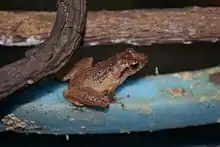Romer's tree frog
Romer's tree frog (Liuixalus romeri)[1] is a species of frog endemic to Hong Kong. With an average snout-vent length of 1.5 – 2.5 cm, it is the smallest amphibian recorded in the territory. Despite its common name, it belongs to the family Rhacophoridae, instead of the Hylidae.
| Romer's tree frog | |
|---|---|
 | |
| Scientific classification | |
| Kingdom: | Animalia |
| Phylum: | Chordata |
| Class: | Amphibia |
| Order: | Anura |
| Family: | Rhacophoridae |
| Genus: | Liuixalus |
| Species: | L. romeri |
| Binomial name | |
| Liuixalus romeri (Smith, 1953) | |
| Synonyms | |
|
Philautus romeri Smith, 1953 | |
Description
The female frog is slightly larger than the male. The body is tan brown, with the underside white. An X-like marking, made up of two crooked black lines, can be seen on the dorsum. Sometimes, the lines do not meet medially, thus leading to a chevron marking posteriorly. Underneath the X-like marking lies another upside-down V-like marking. The skin is peppered with fine granules. A distinct fold extends from the eye to the foreleg.
Romer's tree frog has a triangular but blunt snout with brown-spotted lips. Between the eyes is a dark bar, which extends to the eyelids. The hind legs are long, slender, and barred with irregular brown-to-black cross-bands. All digits have small toe pads, which allow the frog to hang on tree branches or leaves.
Ecology and behaviour
The habitat of the frog is well-wooded areas near small streams or other water sources suitable for breeding. This frog usually sits on low bushes, buries itself in fallen leaves, or rests on bare ground. The frog has been recorded solely from four of the outlying islands in Hong Kong, namely Lantau Island, Lamma Island, Po Toi Island and Chek Lap Kok.
Its tadpoles and eggs are susceptible to predation by the introduced mosquitofish, and it is only able to breed in places where the fish has yet to colonise. The frog breeds in shallow water from early March to September. The male has a shrill, staccato call. The female glues up to 120 eggs onto submerged plant debris, stones, or vegetation. The tadpoles, brown in colour, require 4 to 6 weeks to metamorphose in captivity.
Adults feed on termites, and such small insects as crickets and arachnids such as spiders. The frog is strictly nocturnal. It lives about three years in the wild, but the female is reproductively active only for two breeding seasons.
Discovery and conservation
Romer's tree frog was named after John D. Romer, who first discovered it in a cave on Lamma Island in 1952. That population disappeared in 1953 due to the collapse of the cave. Once thought to be extinct, the frog was rediscovered on the island in 1984.
Over 200 individuals of the species were rescued from Chek Lap Kok in 1992, before the construction of the new Hong Kong International Airport. The captives were bred successfully and the offspring were released into eight selected sites in Hong Kong Island and New Territories. The frogs in seven of the sites survived. Surprisingly, a very small number of them also survived in Chek Lap Kok.
As an endangered species, Romer's tree frog is protected under the law of Hong Kong (Wild Animals Protection Ordinance, Cap. 170). Part of Ngong Ping in Lantau, a site that supports the largest population of the frog has been designated as a Site of Special Scientific Interest in May 1999.
Footnotes
- Li, Che, Bain, Zhao, and Zhang, 2008, Mol. Phylogenet. Evol., 48: 311. The frog was previously classified under other genera: initially Philautus (Smith, 1953) and later Chirixalus (Bossuyt & Dubois, 2001).
References
- Lau & Ermi (2004). "Chirixalus romeri". IUCN Red List of Threatened Species. 2004. Retrieved 9 May 2006.CS1 maint: ref=harv (link) Database entry includes a range map and justification for why this species is endangered.
- Stephen J. Karsen, Michael Wai-neng Lau and Anthony Bogadek (1998). Hong Kong Amphibians and Reptiles, 2nd ed.. Hong Kong: Provisional Urban Council. ISBN 962-7849-05-7.
External links
| Wikispecies has information related to Liuixalus romeri. |
- Ecological interests: Romer's Tree Frog by the Agriculture, Fisheries and Conservation Department of HKSAR
- Biodiversity Series: How Scientists Saved a Rare Frog Species Found Only in Hong Kong
Not working 28 Oct 2020:
- An introduction by the WWF Hong Kong
- An introduction by the Agriculture, Fisheries and Conservation Department of HKSAR
- Philautus romeri in Hong Kong: a frog re-introduction to a degraded tropical landscape (an article written by the researchers from the University of Hong Kong)
